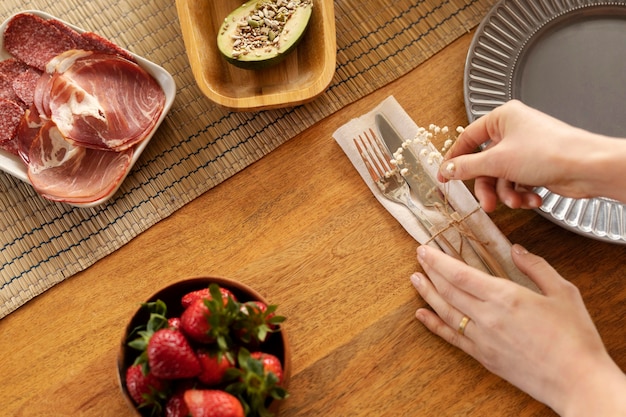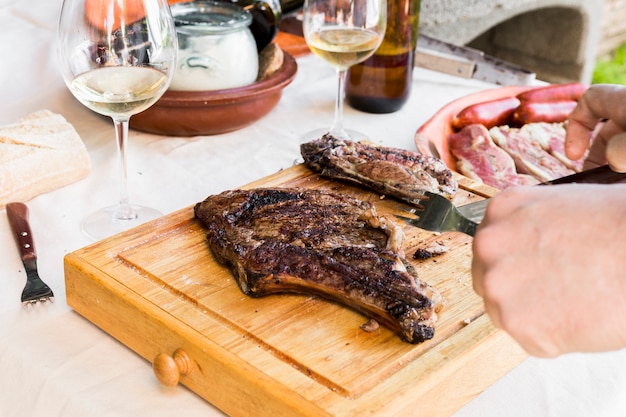There’s something truly satisfying about a perfectly cooked steak. The sizzle on the grill, the aroma that fills the air, and that first, glorious bite - it’s a culinary experience that’s hard to beat. But let’s face it, achieving that perfect doneness can feel like a gamble sometimes. One minute you’re slicing into a succulent medium-rare masterpiece, the next you’re struggling with a dry, overcooked disappointment. But fear not, my fellow steak enthusiasts. I’m here to demystify the art of steak cooking, sharing my hard-earned knowledge and insider tips to help you consistently nail that perfect bite.
We’ll cover everything from choosing the right cut to mastering different cooking techniques and understanding the nuances of different levels of doneness. We’ll even delve into some handy tricks to elevate your steak game to new heights. So grab your apron, sharpen your knives, and let’s embark on this delicious journey together.
Part 1: Choosing Your Steak: A culinary adventure Begins

Before you even fire up the grill or heat up the pan, you need to choose your weapon of choice – the steak itself. Just like you wouldn't go into battle without the right armor, you wouldn’t want to tackle steak without the right cut. The right cut is crucial for achieving the desired texture and flavour. Some cuts are naturally more tender, while others boast a more robust flavour. Let’s explore some popular contenders and their unique qualities:
The Classics:
- Sirloin: This versatile cut is a popular choice for good reason. It offers a good balance of flavour and tenderness, making it suitable for a variety of cooking methods. It’s also relatively affordable, making it a fantastic option for a weeknight meal.
- Rib Eye: Ah, the rib eye. Known for its rich marbling and buttery flavour, it’s a real crowd-pleaser. The marbling – those streaks of fat – adds incredible flavour and tenderness. It’s a bit pricier than sirloin, but it’s worth the splurge for a special occasion or a night in when you want to treat yourself.
- filet mignon: The epitome of luxury, filet mignon is incredibly tender and melts in your mouth. It’s lean, delicate, and perfect for those who prefer a subtler flavour profile. You’ll often find filet mignon served with a rich, buttery sauce to enhance its delicate flavour.
The Adventurous:
- new york strip: This cut packs a punch with its bold flavour and a good amount of marbling. If you crave a more intense steak experience, the New York strip is the one for you. It’s fantastic grilled or pan-seared.
- T-bone: This is a real showstopper. It combines a tender filet mignon with a flavorful strip steak, making it a great choice for a dinner party. The "T" shape is unmistakable, and it’s a real conversation starter.
- flank steak: This cut is lean and flavorful, with a distinct grain. It can be a little tougher than other cuts, but it’s a fantastic choice for grilling and slicing thinly against the grain. Think about using it for fajitas or stir-fries.
Personally, I’m a huge fan of ribeye. It's got that perfect balance of flavour and tenderness that's hard to resist. But if you're looking for something more budget-friendly, sirloin is a great alternative. And if you're feeling adventurous, try the New York strip for a taste explosion. Whatever you choose, make sure the cut is at least an inch thick. This will help it retain its moisture and cook evenly, ensuring a juicy and flavorful steak.
Part 2: Deciphering Doneness: Understanding the Levels of Perfection

Now, let's talk about the heart of the matter: doneness. It's the holy grail of steak cooking, and understanding the different levels is essential for achieving your desired outcome. Let's dive in, explore the nuances, and discover what makes each level unique:
Rare:
- Temperature: 125-130°F (52-54°C)
- Appearance: The centre will be a vibrant red, cool to the touch, with a slight give when pressed. The edges will be brown and slightly cooked. It’s a dramatic contrast that highlights the rawness within.
- Texture: Very soft and yielding, almost like butter. It’s a true test for those who enjoy a truly uncooked core.
Medium-Rare:
- Temperature: 130-135°F (54-57°C)
- Appearance: The centre will be mostly red, with a slight pink tinge, becoming warmer to the touch. The edges will be brown and slightly firmer, indicating the start of a cooked exterior.
- Texture: Soft and slightly springy, with a delicate chew that melts in your mouth. It's a popular choice for its balance of tenderness and flavour.
Medium:
- Temperature: 135-140°F (57-60°C)
- Appearance: The centre will be mostly pink, with a small amount of red, with a warm feel to the centre. The edges will be brown and firm, indicating a more cooked exterior.
- Texture: More firm than medium-rare, but still tender. This level offers a more cooked centre with a noticeable texture change.
Medium-Well:
- Temperature: 140-145°F (60-63°C)
- Appearance: The centre will be mostly brown, with just a hint of pink, and warm throughout. The edges will be brown and very firm, indicating a well-cooked exterior.
- Texture: Firm and slightly chewy, with a noticeable difference in texture from the centre to the edges. It's a balance between a cooked centre and a juicy bite.
Well-Done:
- Temperature: 145-150°F (63-66°C)
- Appearance: The centre will be completely brown, with no pink, and will be hot throughout. The edges will be brown and very firm, indicating a thoroughly cooked steak.
- Texture: Very firm and chewy, with a distinct texture throughout. It’s a preference for those who enjoy a thoroughly cooked steak.
Personally, I'm a huge fan of medium-rare. The soft texture, the juicy red centre, and the perfect balance of flavour are irresistible. But remember, doneness is a matter of personal preference. Don’t be afraid to experiment and find your perfect level of doneness. And if you’re ever unsure, use a meat thermometer – it’s your secret weapon to consistently achieving your desired results.
Part 3: Mastering the Grill: Embracing the Outdoor Element

Grilling is a classic steak cooking method, and for good reason. It imparts a beautiful char and smoky flavour that’s hard to resist. But it’s important to get the grill temperature right to avoid overcooking or burning your steak. Here's how to set up for grilling success:
The Perfect Grill Setup:
- Preheat the grill: Ensure your grill is nice and hot. Aim for a temperature of around 450°F (232°C). You can test this by holding your hand a few inches above the grate - you shouldn't be able to hold it there for more than 3 seconds.
- Clean the grill: Make sure your grill grates are clean. This will prevent your steak from sticking and ensure even cooking. Use a grill brush to remove any leftover food particles.
- Oil the grates: A light coating of oil on the grates will help prevent sticking and add a nice sear to your steak. Use a paper towel to lightly apply a thin layer of oil.
Grilling Technique:
- Season generously: Season your steak liberally with salt and pepper. You can also add other spices like garlic powder, onion powder, or paprika, if you prefer. Salt helps draw out moisture, while pepper adds a subtle kick.
- Sear on both sides: Place your steak on the hot grill and sear for 2-3 minutes per side. This will create a beautiful crust and lock in the juices. Listen for that satisfying sizzle.
- Reduce the heat: After searing, reduce the heat to medium and continue cooking for another 2-5 minutes per side, depending on your desired doneness. Keep a close eye on it, as cooking times can vary.
- Rest and serve: Once your steak is cooked to your liking, remove it from the grill and let it rest for 5-10 minutes before slicing and serving. This allows the juices to redistribute throughout the steak, resulting in a more tender and juicy steak.
Remember, these are just guidelines. The best way to determine doneness is to use a meat thermometer. Insert it into the thickest part of the steak and check the temperature against the chart above. It’s a foolproof way to avoid overcooking your precious steak.
Part 4: The Magic of the Pan: Unlocking the Power of Searing
If you’re not a grill master or simply prefer a more controlled environment, pan-searing is a fantastic alternative. It’s a simple and effective method that yields delicious results, especially when using a cast-iron pan. Here’s how to make your pan-searing dreams a reality:
Pan-Searing Essentials:
- Choose the right pan: A cast-iron skillet is ideal, as it distributes heat evenly and retains heat well. It creates a beautiful sear and adds a subtle iron flavour. But any heavy-bottomed pan will do.
- Preheat the pan: Heat your pan over medium-high heat for a few minutes. You should see a light shimmer on the surface of the pan, which indicates that it's hot enough.
- Oil the pan: Add a tablespoon or two of oil to the pan and swirl it around to coat the entire surface. You can use any neutral oil with a high smoke point like canola or grapeseed oil.
Searing Technique:
- Season generously: Season your steak generously with salt and pepper. You can also add other spices like garlic powder, onion powder, or paprika, if you prefer.
- Sear on both sides: Place your steak in the hot pan and sear for 2-3 minutes per side. You should hear a sizzling sound as the steak hits the pan. The sear is crucial for creating that delicious crust.
- Reduce the heat: After searing, reduce the heat to medium and continue cooking for another 2-5 minutes per side, depending on your desired doneness. Adjust the cooking time according to the thickness of your steak.
- Rest and serve: Remove the steak from the pan and let it rest for 5-10 minutes before slicing and serving.
A little tip, you can add a knob of butter to the pan in the last few minutes of cooking. This will add a rich, buttery flavour to your steak. Just remember to baste the steak with the butter using a spoon. It’s a simple touch that elevates the flavour to a whole new level.
Part 5: Exploring Other Cooking Methods: Unveiling New Possibilities
Beyond the grill and the pan, there are other exciting ways to cook steak. Let’s explore some alternative methods that might surprise you and offer a unique approach to achieving that perfect bite:
Sous Vide:
sous vide cooking is a technique that involves immersing the steak in a water bath at a precise temperature for a set amount of time. It’s a great way to ensure even cooking and achieve perfect doneness. The steak cooks slowly and evenly, resulting in a consistently tender and juicy steak. But remember to sear the steak after it’s cooked in the water bath to achieve that delicious crust. This technique offers precision and control, ensuring consistent results.
reverse searing:
Reverse searing involves cooking the steak in a low-temperature oven before finishing it on the grill or in a pan. This allows the steak to cook evenly and retain its moisture. It’s a fantastic technique for achieving a perfectly cooked steak, but it does require a bit more time. The steak cooks gently in the oven, ensuring even doneness, and then the final sear adds that crispy, flavourful exterior.
Air Fryer:
You can even cook steak in an air fryer! It’s a quick and convenient method that yields surprisingly delicious results. Just be sure to check the steak frequently to avoid overcooking. The air fryer circulates hot air around the steak, creating a crispy exterior and a cooked interior. It’s a great option for a quick and easy weeknight meal.
These methods offer diverse avenues for exploring steak cooking and cater to various preferences. Experiment with each to discover what suits your taste and lifestyle best.
Part 6: The Power of Rest: Unlocking the Secrets to Juiciness
After all that effort, it’s time to let your steak relax and recover. Letting the steak rest is crucial for achieving optimal flavour and tenderness. It allows the juices to redistribute evenly throughout the meat, resulting in a more juicy and flavorful steak. It’s the final touch that transforms a good steak into a truly memorable one.
Why Rest Matters:
- Moisture Retention: During cooking, the steak’s proteins contract, squeezing out the juices. As the steak rests, the proteins relax, allowing the juices to be reabsorbed, making it more tender and juicy. It’s like a little post-workout recovery for your steak.
- Flavor Distribution: Resting allows the flavours to evenly distribute throughout the steak, creating a more harmonious taste profile. It’s a chance for all those delicious flavours to mingle and create a symphony of taste.
How Long to Rest:
The general rule of thumb is to rest your steak for 5-10 minutes. For larger steaks, you can rest them for up to 15 minutes. You can use a cutting board or a wire rack to rest the steak. This allows air to circulate and helps the juices redistribute more efficiently.
Part 7: The Art of Slicing: Revealing the Exquisite Interior
The final step is slicing your steak. This seemingly simple act can make a big difference in the overall eating experience. Here's what you need to know to make your slicing a masterpiece:
Slicing Technique:
- Use a sharp knife: A sharp knife will cut through the steak cleanly and effortlessly. A dull knife will tear the meat, resulting in uneven slices. Invest in a good quality knife and keep it sharp.
- Slice against the grain: This will help to break down the muscle fibres and make the steak more tender. The grain refers to the direction of the muscle fibres. You can usually identify it by looking at the steak - the grain will look like lines running along the surface. Slice perpendicular to these lines.
- Slice into even pieces: Try to slice the steak into even pieces. This will ensure that each bite has a similar texture and flavour. It’s like creating a visual feast as well as a delicious one.
A well-sliced steak is a delight to behold, each slice revealing the perfect doneness and the juicy, flavorful interior. It’s a testament to the care and skill invested in the entire cooking process.
Part 8: steak sides: Elevating the Meal to New Heights
No steak is complete without a delicious side dish to complement it. From classic potato dishes to vibrant salads, the options are endless. Here are a few ideas to get your culinary juices flowing and create a well-rounded meal:
Starchy Companions:
- mashed potatoes: Creamy and comforting, mashed potatoes are a classic steak side dish. They offer a comforting and creamy counterpoint to the steak’s savory flavour.
- Roasted Potatoes: Crispy on the outside and fluffy on the inside, roasted potatoes offer a delightful contrast in texture. They add a rustic and earthy element to the meal.
- baked potato: A simple yet satisfying side, baked potatoes can be topped with various toppings like cheese, sour cream, or chives. They’re a blank canvas for creativity and customization.
- potato gratin: A decadent and elegant side dish, potato gratin is a creamy and cheesy concoction that perfectly complements a juicy steak. It’s a luxurious and indulgent choice that elevates the meal to a special occasion level.
Green Delights:
- Asparagus: Grilled or roasted asparagus adds a vibrant touch and a delicate, earthy flavour. It’s a seasonal favourite that pairs beautifully with steak.
- green beans: Steamed or sauteed green beans are a healthy and refreshing side dish. They offer a crisp and bright counterpoint to the steak’s richness.
- Broccoli: Roasted or steamed broccoli offers a satisfying crunch and a healthy dose of vitamins. It’s a versatile vegetable that can be dressed up or down to suit your preference.
Other Options:
- Mushroom Sauce: A rich and savory sauce, mushroom sauce elevates the steak to new heights of flavour. It’s a classic pairing that adds a depth of umami and complexity.
- grilled corn on the Cob: Sweet and smoky, grilled corn on the cob is a delicious and festive side dish. It’s a vibrant and flavourful addition to any steak meal.
Don't be afraid to get creative and experiment with different combinations. A well-chosen side dish can enhance the overall dining experience and create a memorable meal. It’s a chance to showcase your culinary skills and create a truly satisfying experience.
Part 9: FAQs: Addressing the Most Common Steak Conundrums
Let’s tackle some common questions about steak cooking to ensure you have all the answers you need:
Q: How do I know if my steak is cooked to my liking without a meat thermometer?
If you don’t have a thermometer, you can use the “finger test” as a rough guide. Press the centre of the steak. If it feels similar to your fingertip, it’s rare. If it feels like the pad of your thumb, it’s medium-rare. If it feels like the tip of your nose, it’s medium. But this method is not always reliable, and it’s best to use a thermometer for accurate results. A thermometer is the most accurate way to ensure you achieve your desired doneness.
Q: How long should I cook a steak?
The cooking time for a steak depends on the thickness, the cut of meat, and your desired doneness. As a general rule of thumb, a 1-inch thick steak will take about 4-6 minutes per side for medium-rare. Adjust the cooking time accordingly for different thickness and doneness levels. Keep a close eye on your steak and adjust the cooking time based on your preference.
Q: What’s the best way to prevent my steak from drying out?
The key is to cook the steak quickly over high heat. This creates a nice sear that locks in the juices. Also, avoid overcooking the steak. Overcooking will dry out the meat. High heat and careful monitoring are crucial for a juicy steak.
Q: What can I do if I accidentally overcooked my steak?
If you've overcooked your steak, there's not much you can do to undo the damage. But you can try to salvage the situation by slicing the steak thinly against the grain and serving it with a rich sauce. This helps break up the tougher texture and adds a layer of flavour.
Q: What’s the best way to store leftover steak?
Leftover steak can be stored in an airtight container in the refrigerator for up to 3-4 days. You can reheat it in the oven, microwave, or on the stovetop. Make sure to cool the steak completely before storing it in the fridge to prevent bacteria growth.
Armed with this knowledge, you’re ready to tackle any steak challenge. So, next time you’re craving a juicy, flavorful steak, unleash your inner grill master, experiment with different cooking methods, and relish the satisfaction of achieving perfect doneness. Happy grilling!
Everyone is watching

Perfect Rice Every Time: The Ultimate Guide to Cooking Rice
Cooking TipsAs a self-proclaimed foodie, I've always been a bit obsessed with rice. It's the foundation of countless cuisi...

The Ultimate Guide to Cooking Asparagus: Tips, Techniques, and Recipes
Cooking TipsAsparagus. The mere mention of this spring delicacy conjures up images of vibrant green spears, crisp and burs...

Ultimate Guide to Cooking the Perfect Thanksgiving Turkey
Cooking TipsThanksgiving. Just the word conjures up images of overflowing tables laden with delicious food, the scent of r...

Prime Rib Roast Cooking Time Chart: Per Pound Guide
Cooking TipsPrime rib roast. Just the name conjures images of lavish dinners, crackling fires, and hearty laughter. It’s ...

Can You Cook Spaghetti with Gasoline? (The Shocking Truth)
Cooking TipsWe've all seen those crazy internet trends. You know, the ones that make you wonder, "Did someone actually try...
